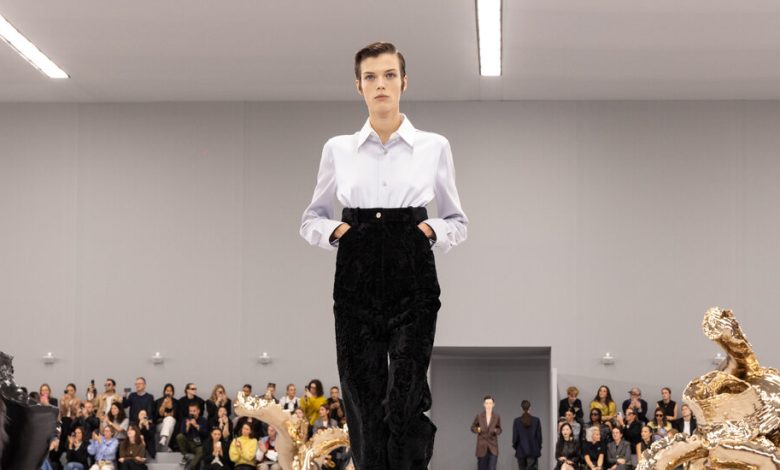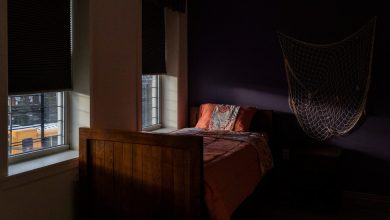Shoes on the Table! And Other Challenges to the Fashion Status Quo

Backstage after his autobiographical and quasi-retrospective Balenciaga show, Demna, the mononymic bearded creative director of the brand, was standing in a long hooded black coat like some sort of rebel wizard and holding up his iPhone to show off a photo.
It was a snapshot of him, in a navy polo shirt and white Bermudas, standing next to his husband and the show’s music producer, Loïk Gomez, known as BFRND, who had closed the show as the bride. In the picture, BFRND was wearing chinos with the cuffs rolled up and a white button-down shirt. Both men had on loafers, and looked as if they were off to brunch at the country club.
“This summer, Loïk and I, we had a very horrible experience in South of France,” Demna said, describing how people had asked to be moved away from them in a restaurant because their usual black oversize clothes made them look so strange. “So the day after,” he said, “we went and bought some clothes to look like that, to try to blend in.” It was, he said, a thought experiment to experience just how much what we wear “defines how the world around us perceives us”; how clothes interact with identity, internally and externally.
That should not exactly be news to a designer — interrogating those social perceptions and offering people new ways to challenge them and manipulate them is literally the job — but it’s not bad to be reminded of it every once in awhile.
So Demna put a new handbag on his runway. That looked exactly like a man’s leather dress shoe (well, this is the designer who gave us the Ikea bag as a luxury item). “Why is a shoe supposed to be on your foot?” Demna asked. Why not, he went on, question those rules? When he brought one of the prototype shoe-bags to an event and put it, as one does with bags, on the dinner table next to his plate, “It kind of revolted a couple of people,” he said. Shoes on the table! Shocking!
Think again.
The False Fashion Binary
Maybe it’s because this is a moment of either/or in so much of public life — either you’re with us or against us; either you’re on one side or the other — but increasingly it seems there is a narrative developing in fashion that says either a brand has to make the familiar (recognizable clothes that have the absolute comfort of the familiar) or it has to declare allegiance to the wildly conceptual (not-clothes clothes that push the boundaries of imagination, but make the watching public scream “who would wear that?”). And never the twain shall meet.
The lodestar of the first group is Hermès, where this season the designer Nadège Vanhée built an entire meadow of gently oscillating grasses in which to place her gently luxurious leathers and curving silk knits in saddlery shades. And it includes such card-carrying members as The Row, where Mary-Kate and Ashley Olsen riff reliably on the Zen appeal of the easy trouser suit and the tailored schmatta (in their hands, not actually an oxymoron).
This time the Olsens did it with towels slung round the neck like scarves and bedroom slippers, the better to convey extreme relaxation of line. Such clothes are tantalizing in their ease, but they err on the side of the awfully undemanding.
By contrast comes the work of the conceptualists, led by Rei Kawakubo of Comme des Garçons, with her grand constructions of (this season) ribbons and candy-colored pixel-printed materials, like totems of childhood sent through the looking glass: ginormous tote bags and collars and bows, all mishmashed together into monstrously optimistic forms.
Also Kei Ninomiya, of Noir, whose specialty is transforming filaments and fractals into fronds of otherworldly life that swirl and gyrate around the body, sometimes swallowing it whole so it looks like nothing so much as a rapacious species of alien botany. The result can be dazzling and sometimes ridiculous, but it never makes you yawn. (It also never says: “Work wardrobe!” It often doesn’t even say: “You can sit down in this.”)
Mr. Ninomiya did that again this season, though he also began his show with a series of harnesses made from wirelike suspenders that (yes) suspended but also trapped the recognizable skirts and shirts beneath in a hint at more practical applications of his ideas. And indeed, the notion that when it comes to a wardrobe you can’t have your clothes and concept too is, frankly, baloney.
It’s exactly the combination of the two that changes how we dress and how we understand ourselves, and it’s that combination that should be the goal. To separate the two — to think “OK, this is the wearable stuff and this is the fun, wacky stuff” — is to give up on the real value of fashion.
Changing Shapes
Classically, the place that the outré and the everyday meet is most often silhouette, and it is in figuring out new proposals for the silhouette that designers most often shift our sense of self. They are literally shifting the proportions of the body.
There are other ways to do it, of course. Yohji Yamamoto forces a new reckoning with history every time he splices time periods and gender uniforms together; every time he tugs a deliberately placed white string in a black suit here or frays a hem there. Glenn Martens of Y/Project challenges material convention when he makes denim into frothing confections of frills, or hangs a slip dress from a transparent fishing line, so it magically seems to stand up on its own.
But it’s silhouettes that tend to resonate most widely, in part because they are immediately startling to the eye.
It is why Demna first became famous at Balenciaga: for taking the stuff of streetwear and rendering in the precious forms of the very, very fancy, before he went off a tangent that prioritized scenography-led social commentary over stuff, and then tripped over his own commentary into a public brouhaha. He’s been trying to inch his way back ever since, and after last season’s penitential show — one he repudiated backstage, saying, “It was polished, and I don’t like when it is polished” — he seemed to be trying to find a new balance.




Balenciaga, spring 2024Credit…Balenciaga
To do that he built a grand theater entirely swathed in curtains of red velvet, and then paraded out an assortment of people whom he said had been meaningful in his life, starting with his mother, who opened the show in a trench coat made from three different upcycled coats, so there were essentially two pairs of arms: one to dangle empty and suggest the coat had been thrown over her shoulders like a cape, and one to actually house her real arms.
And so it went, with models, former art schoolteachers, employees and friends — all wearing versions of Demna’s now-familiar Balenciaga-isms: “Stop Making Sense”-size jackets; exaggerated motorcycle leathers; fan-pleated floral gowns; bathrobe coats that looked exactly like bathrobes; hoodies and long black dresses sparkling like the sky at night.
While the jutting shoulders of the jackets (made without shoulder pads) might have been even more exaggerated than usual and the sneakers even more duckfooted, the vernacular is starting to seem rote — and the repetition like a rut. Perhaps upcycling, which was extended to leather jackets and some of the evening gowns, points to a potential way forward.
The Loewe Effect
Silhouette is also why Jonathan Anderson’s Loewe is currently so influential. Mr. Anderson has a tendency to spew ideas out pell-mell onto his catwalk, some of which seem gimmicky (the giant straight pin used to hold up the waistband on a pair of city shorts) and some amusingly subversive (a trench coat with one of the tails caught in a shoulder bag to expose the leg up to the bottom). Others, however, are immediately desirable (sweeping chunky knit capes), and occasionally some are just discomfiting enough to change the status quo.
This season he did it with a silhouette that involved ultra high-waist pants (the kind he first showed in his men’s collection earlier this summer) that rise to just under the bust, with a little corset built in to hold the shape. With them he paired truncated button-up shirts, crafty knits and tops seemingly made of glittering leaves.
The effect is to lengthen the legs — the part of the body associated with movement and self-propulsion — shrink the torso, and change how you stand: To put your hands in your pockets, you need to pinch your elbows and shoulders back, so they look sort of like wings, which thrusts the chest forward. There’s no slouching. If Empress Josephine were strolling down Madison Avenue en route to a midafternoon meeting, this is how she might look.
The point, Mr. Anderson said after the show, was that you see the pants and you think, “I know that.” But then you look again, and realize you don’t at all. At first it looks bizarre, and then it looks interesting. And then, perhaps, it looks like something to wear.




